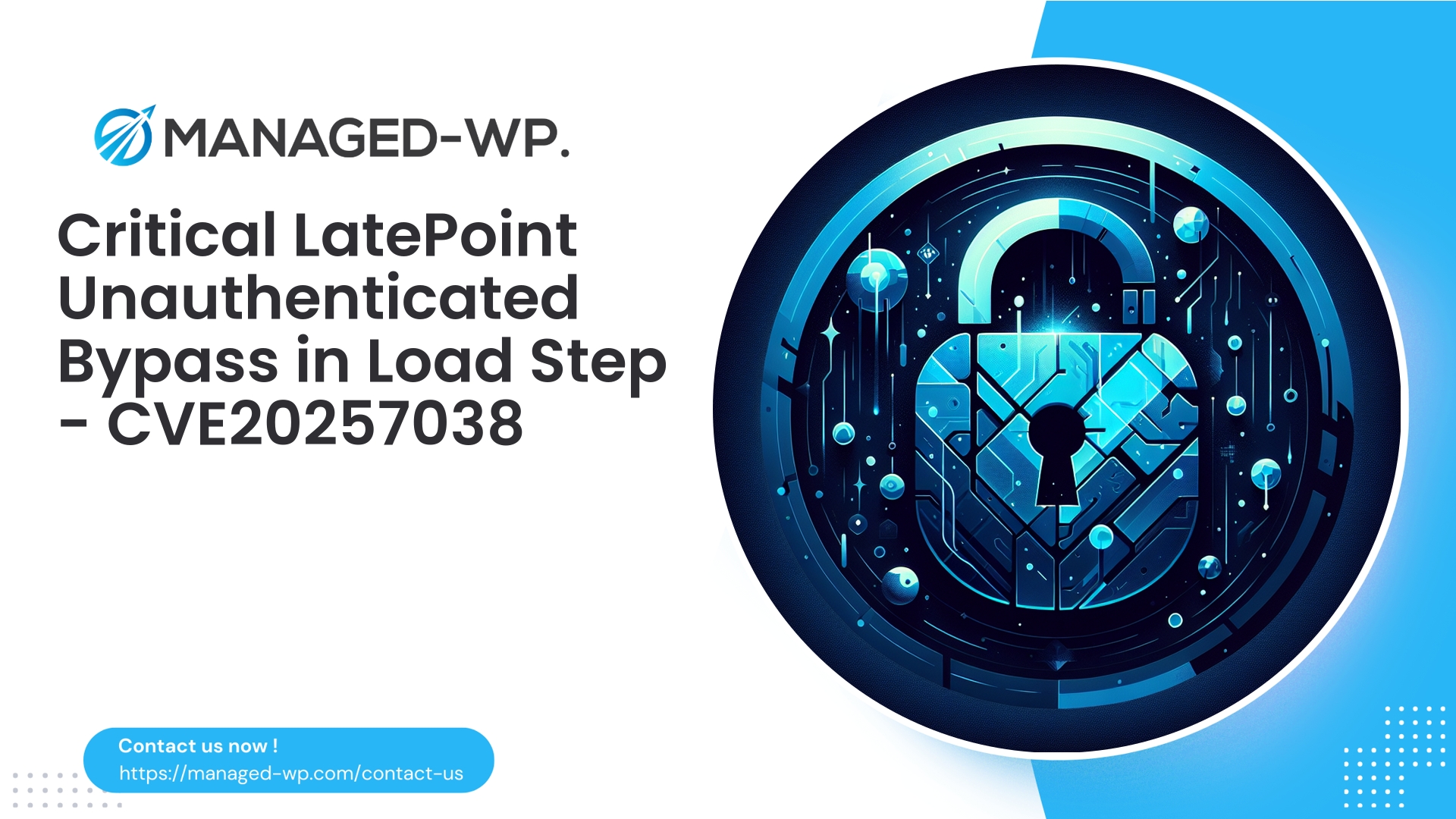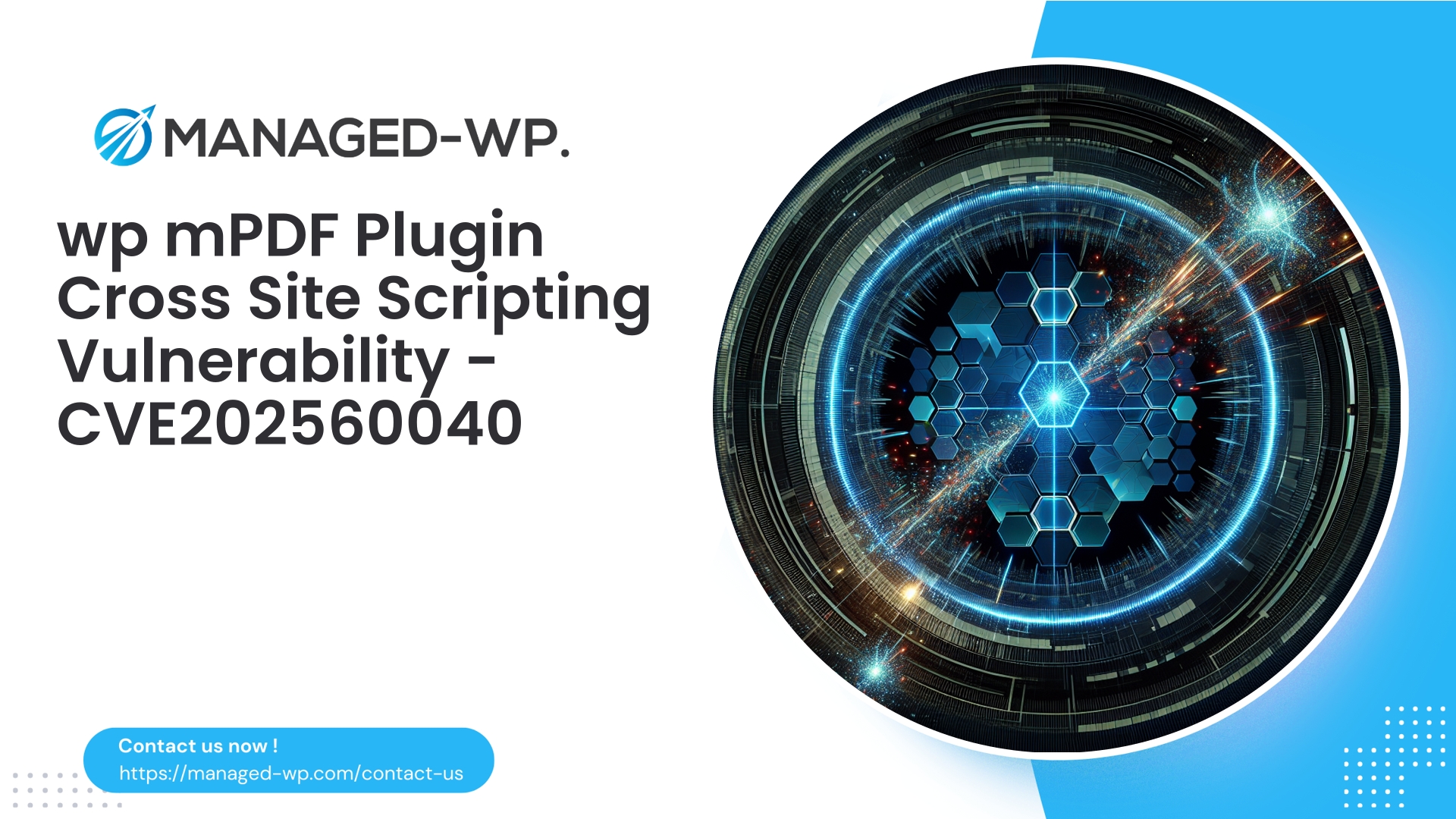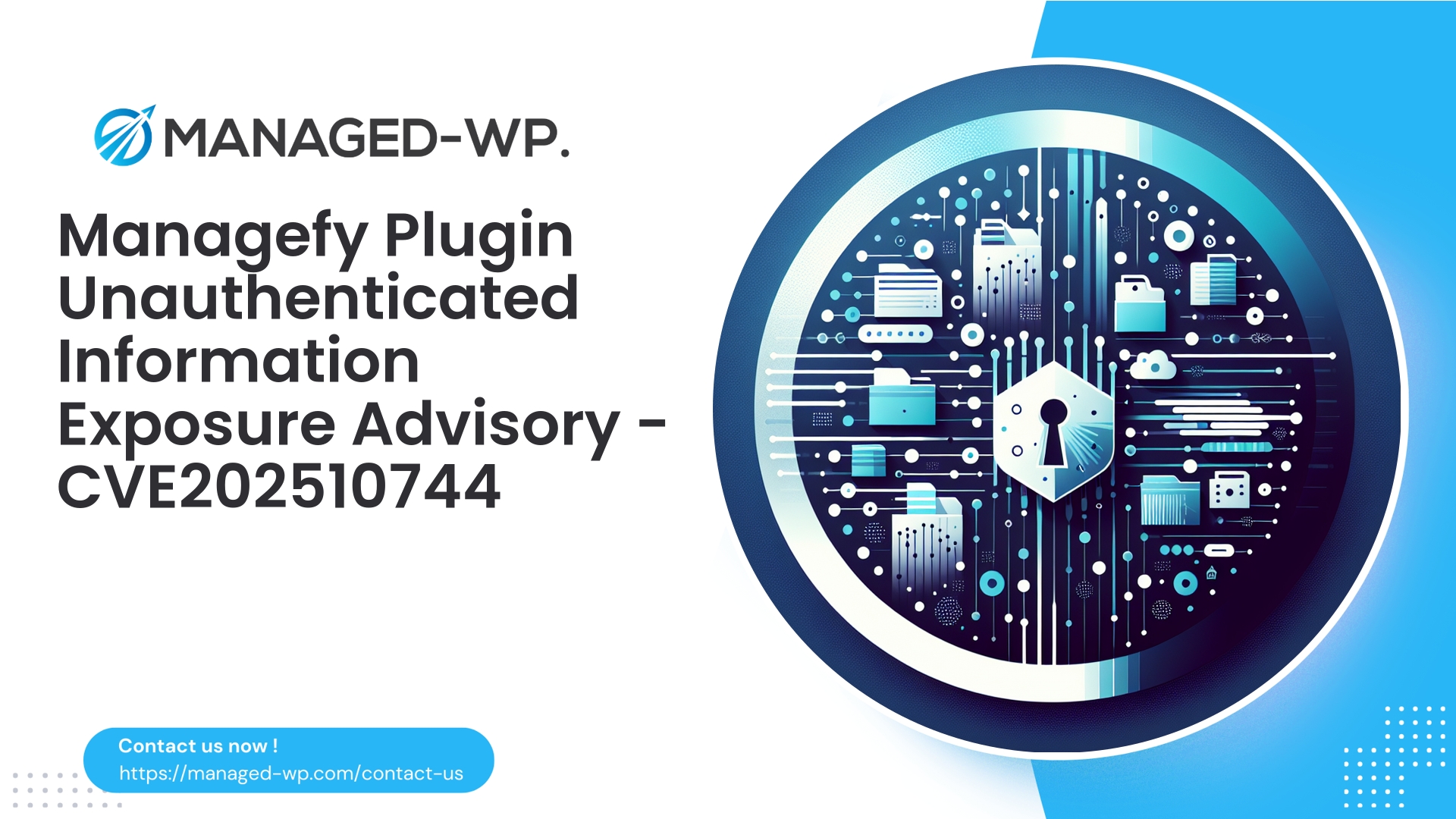| 插件名称 | 后期点 |
|---|---|
| 漏洞类型 | 身份验证绕过 |
| CVE编号 | CVE-2025-7038 |
| 紧急 | 高的 |
| CVE 发布日期 | 2025-09-30 |
| 源网址 | CVE-2025-7038 |
LatePoint ≤ 5.1.94 — 严重身份验证漏洞 (CVE-2025-7038):WordPress 网站管理员必须采取的措施
作者: 托管 WordPress 安全团队
日期: 2025-09-30
概括: 编号为 CVE-2025-7038 的严重身份验证绕过漏洞会影响 LatePoint 插件 5.1.94 及更早版本。该漏洞允许未经授权的攻击者执行仅限已认证用户才能执行的操作。此问题已在 LatePoint 5.2.0 中修复。本简报概述了相关风险、利用方法、检测技术、包括 WAF 配置在内的即时缓解措施,以及 Managed-WP 如何在整个修复过程中保护您的网站。
为什么这种漏洞需要立即关注
LatePoint 是一款广受欢迎的 WordPress 插件,用于预约安排和预订功能。此次披露的身份验证绕过漏洞的 CVSS 评分为 8.2(高危),影响所有运行 5.1.94 或更低版本的 LatePoint 实例。由于利用此漏洞无需任何预先身份验证,攻击者可以发起自动化的大规模攻击。漏洞利用可能导致账户被盗用、权限提升或未经授权的交易。使用 LatePoint 的 WordPress 网站运营者应立即优先进行更新和漏洞缓解措施。
漏洞技术分析
- 脆弱性的本质: 身份验证机制失效导致身份验证绕过。
- 受影响的软件: LatePoint WordPress 插件,版本≤5.1.94。
- 漏洞 ID: CVE-2025-7038。
- 补丁可用性: LatePoint 版本 5.2.0 中已修复。
- 披露: 由独立安全研究人员报告,并在公开公告中详细说明。
- 影响细节: 攻击者可以调用插件端点(特别是“load_step”功能),绕过身份验证检查或操纵会话状态,从而执行通常仅限于已登录用户的未经授权的操作,根据站点配置,可能包括管理功能。
根本原因是公共可访问端点(通常在预订流程中通过 AJAX 调用)的验证机制不足,未能强制执行身份验证或正确验证 nonce 值。这一设计缺陷允许未经身份验证的请求通过预订流程并执行特权操作。
评估可利用性和风险
- 可利用性: 风险极高。该易受攻击的端点可公开访问,且无需身份验证,这大大简化了自动化攻击。
- 攻击面: 任何运行 LatePoint 版本 5.1.94 或更早版本的活跃 WordPress 网站,尤其是那些公开显示预订界面的网站。
- 成功利用漏洞的后果包括:
- 劫持用户会话并冒充合法用户。
- 操纵或伪造预订请求,这些请求可能用于欺诈或社会工程。
- 通过下游集成(例如通知或 Webhook)触发副作用。
- 对于访问控制薄弱或重复使用凭据的网站,存在完全管理员权限被攻破的风险。
由于无需身份验证,大规模自动化扫描和攻击很可能在信息公开后不久便会开始。因此,立即采取应对措施至关重要。
建议立即采取的行动
- 修补插件:
- 请立即将 LatePoint 更新至 5.2.0 或更高版本;此更新包含全面的修复程序。
- 如果立即更新不可行,请采取以下临时缓解措施。
- 更新延迟时的临时缓解措施:
- 暂时停用 LatePoint 插件,直到可以安全更新为止。
- 通过防火墙或WAF规则限制对LatePoint插件端点的访问。
- 尽可能在 WordPress 管理后台实施 IP 白名单机制。
- 通过轮换身份验证密钥和 cookie 强制注销所有现有会话(有关指导,请参阅 WordPress 文档)。
- 实施强身份验证控制:为所有管理员启用双因素身份验证 (2FA) 并应用严格的密码策略。
- 审计是否存在泄露迹象:
- 检查用户创建日期和角色是否存在意外变更。
- 检查 WordPress 数据库表,例如:
wp_options,wp_posts, 和wp_postmeta可疑条目。 - 检查插件和主题目录、上传文件以及其他相关文件夹中是否存在未经授权的 PHP 文件。
- 分析计划任务(wp-cron)和任何新添加的 webhook。
- 检查服务器和访问日志,查找对 LatePoint 端点的异常请求,特别是包含“load_step”的 admin-ajax.php 调用。
- 在进行任何清理或改造之前,请保存日志和证据。
- 重置并保护凭证:
- 更改所有管理员帐户和任何已泄露凭据的密码。
- 轮换与预订工作流程相关的 API 密钥和 webhook 令牌。
- 在 WordPress 内部更新安全盐值
wp-config.php立即使所有活动会话失效。(注意:这将注销所有用户。) - 撤销并重新颁发 LatePoint 使用的所有集成令牌。
- 与利益相关者沟通:
- 将漏洞情况和补救措施告知您的内部团队,并在适当情况下告知受影响的客户。
- 确保遵守您所在行业或司法管辖区的任何违规通知政策。
检测:日志中需要监控哪些内容
检查 HTTP 服务器日志和 WordPress 调试日志,查找可能表明存在攻击企图的可疑模式。尤其要注意以下方面:
- 请求
admin-ajax.php或其他带有参数的 AJAX 端点,例如:操作=后期加载步骤action=latepoint_load_step_ajax- 包含任何 URL
/latepoint/结合加载步.
- 预订工作流程中典型的一系列步骤,这些步骤以快速或异常的方式执行,尤其是从同一 IP 地址执行。
- 包含预订参数但源自未经身份验证或可疑客户端的异常 POST 请求。
- 与预订相关的前端页面流量激增。
- 新用户出现的同时伴随着可疑活动:
- 查看最近用户的示例 SQL:
SELECT ID, user_login, user_email, user_registered FROM wp_users ORDER BY user_registered DESC LIMIT 20; - 用于检查用户权限的示例 SQL:
SELECT * FROM wp_usermeta WHERE meta_key LIKE '%capabilities%';
- 查看最近用户的示例 SQL:
- 上传文件、插件或主题目录中出现近期修改时间异常的新文件。
用于缓解措施的 WAF / ModSecurity 签名示例
部署虚拟补丁规则可以在准备或测试正式更新时降低风险。以下是一些配置示例;请根据您的环境进行调整,并首先在监控模式下进行验证。
ModSecurity 规则(OWASP CRS 风格)
SecRule REQUEST_METHOD "POST" "id:100501,phase:2,block,log,msg:'Block LatePoint load_step unauthenticated attempt',chain" SecRule REQUEST_URI "@contains admin-ajax.php" "chain" SecRule ARGS_NAMES|ARGS|REQUEST_HEADERS|REQUEST_BODY "@rx (action=.*latepoint.*load_step|latepoint_load_step)" "t:none"
NGINX 位置块
location ~* /wp-admin/admin-ajax.php$ { if ($request_method = POST) { set $block_latepoint 0; if ($arg_action ~* "latepoint.*load_step") { set $block_latepoint 1; } if ($block_latepoint = 1) { return 403; } } include fastcgi_params; fastcgi_pass unix:/run/php/php7.4-fpm.sock; }
Apache 的 .htaccess 规则
RewriteEngine On RewriteCond %{REQUEST_URI} admin-ajax.php [NC] RewriteCond %{QUERY_STRING} (action=.*latepoint.*load_step|latepoint_load_step) [NC] RewriteRule .* - [F]
WordPress MU插件,用于阻止可疑的AJAX调用(临时版)
<?php
// mu-plugin/disable-latepoint-loadstep.php
add_action('admin_init', function(){
if (isset($_REQUEST['action']) && stripos($_REQUEST['action'], 'latepoint') !== false && stripos($_REQUEST['action'], 'load_step') !== false) {
status_header(403);
wp_die('Forbidden');
}
}, 1);
笔记: 如果您的网站需要未经身份验证的预订互动,这些规则可能会中断网站功能。在这种情况下,停用插件比屏蔽插件更安全。
WAF虚拟补丁最佳实践
- 检测并阻止包含易受攻击的操作名称或端点模式的请求。
- 在可行的情况下,这些操作需要有效的 WordPress nonce。
- 限制模拟预订步骤的请求序列的请求速率,以防止滥用。
- 阻止格式错误或意外的参数,这些参数未在正常的工作流程中使用。
- 在发生阻塞时提供通用错误页面,以避免暴露防御逻辑。
泄露事件后调查清单
- 保存证据:
- 导出所有相关的HTTP和PHP日志。
- 对文件系统和数据库执行离线快照。
- 文件系统分析:
- 查找最近修改过的 PHP 文件:
查找 . -type f -mtime -7 -name '*.php' - 检查是否存在混淆或可疑内容。
- 查找最近修改过的 PHP 文件:
- 数据库审查:
- 查询是否存在意外创建的或最近创建的管理员用户:
SELECT * FROM wp_users WHERE user_login NOT LIKE 'wp_%' ORDER BY user_registered DESC; - 检查自动加载的选项和元数据是否存在异常。
- 审核帖子元数据,查找注入的或可疑的内容。
- 查询是否存在意外创建的或最近创建的管理员用户:
- 计划任务和 Webhook:
- 查看 wp-cron 定时任务:
wp cron event list --due-now - 检查 LatePoint 中的第三方 webhook 设置。
- 查看 wp-cron 定时任务:
- 第三方集成:
- 撤销并替换外部集成(例如日历、支付网关或消息平台)使用的 API 密钥。
- 恢复策略:
- 必要时从已验证的备份中恢复;部署前务必离线验证备份。
其他安全加固建议
- 保持 WordPress 核心、主题和插件的最新版本。
- 停用并移除不必要或已弃用的插件。
- 对管理员账户应用最小权限原则。
- 强制要求管理员使用强密码并启用双因素身份验证(2FA)。
- 使用唯一的 API 凭证并定期轮换。
- 定期审核用户权限和活动日志。
- 利用监控工具和警报系统来发现可疑行为。
- 尽可能对管理员后台访问权限实施 IP 白名单机制。
验证有效补救措施
- 请通过 WordPress 管理界面确认 LatePoint 插件已更新至 5.2.0 或更高版本。
- 在测试环境中测试预订工作流程,以验证是否存在功能性回归。
- 确保更新或移除之前阻止合法流量的WAF或防火墙规则。
- 监控日志,查看是否存在持续的可疑活动,并确认拦截效果。
- 对环境进行全面的恶意软件和文件完整性扫描。
系统管理员取证命令
- 追踪 LatePoint 相关日志条目:
grep -i "latepoint" /var/log/nginx/access.log* /var/log/apache2/access.log* | tail -n 200 - 查找最近修改过的 PHP 文件:
查找 /var/www/html -type f -name "*.php" -mtime -7 -print - 列出最近注册的 WordPress 用户:
mysql -u wpuser -p'PASSWORD' wp_database -e "SELECT ID,user_login,user_email,user_registered FROM wp_users ORDER BY user_registered DESC LIMIT 50;" - 检查用户功能元数据:
mysql -u wpuser -p'PASSWORD' wp_database -e "SELECT user_id, meta_key FROM wp_usermeta WHERE meta_key LIKE '%capabilities%';"
网站运营人员沟通技巧
运营面向客户的预订平台时,透明度与谨慎之间必须保持平衡:
- 及时通知受影响用户有关漏洞及已采取的缓解措施。
- 解释采取的纠正措施,例如打补丁和加强监控。
- 如果怀疑密码泄露,建议用户更新密码。
- 为用户提供明确的联系渠道,以便他们报告潜在的安全问题。
Managed-WP 的保护方法
Managed-WP 的使命是为 WordPress 环境量身定制快速威胁检测、预防和事件响应方案。我们的托管防火墙和 Web 应用防火墙 (WAF) 技术提供虚拟补丁功能,在您安排和执行官方插件更新的同时,主动保护您的网站免受 CVE-2025-7038 等已知漏洞的侵害。我们的响应措施包括:
- 立即部署规则以阻止暴露的 LatePoint 漏洞利用模式(例如,带有“load_step”的未经授权的 admin-ajax 请求)。
- 制定规则来验证 nonce 和参数格式,以维护合法的预订体验。
- 实施速率限制和机器人缓解措施以减少攻击面。
- 持续监控,并对诸如新管理员帐户或意外文件更改等指标发出警报。
- 为事件响应提供及时的指导、取证资料和补救措施说明。
使用 Managed-WP 的安全服务意味着您的网站在补丁部署期间保持弹性,从而有效降低风险。
降低未来插件安全风险
鉴于插件是 WordPress 中最常见的攻击途径,应采取分层策略:
- 安装插件前,务必仔细审查其持续维护情况和安全历史记录。
- 尽量减少插件数量,并限制每个插件的权限。
- 在生产环境部署之前,请使用专用的暂存或测试环境进行插件更新。
- 订阅可信的安全公告和漏洞信息源。
- 结合最佳实践,包括 WAF 保护、文件完整性监控和强大的备份系统。
简明事件响应手册
- 确认: 通过日志分析和查询来确定潜在的安全漏洞范围。
- 隔离: 禁用存在漏洞的插件或阻止对受感染端点的访问。
- 包含: 轮换密钥、盐值,并屏蔽违规 IP 地址。
- 根除: 清除恶意程序和未经授权的用户。
- 恢复: 恢复干净的备份或重新安装已打补丁的插件,并重新应用加固步骤。
- 后续: 进行事后分析,改进检测方法,调整策略,并根据需要通知用户。
妥协指标(IOC)
- 未经授权的 POST 请求
admin-ajax.php和行动包含“latepoint”和“load_step”的参数。 - 来自非典型 IP 地址或用户代理的意外或异常 LatePoint 端点请求。
- 创建新的管理员用户帐户的速度异常快,或者成批创建。
- 插件或主题目录中存在未知的 PHP 文件。
- 新安排的 wp-cron 作业或链接到 LatePoint 的 webhook 条目。
- 您的托管环境向未知的外部域发出出站请求,这与可疑的预订相关活动同时发生。
SIEM系统的示例日志签名
- 事件: HTTP POST 请求
/wp-admin/admin-ajax.php - 场地: 查询字符串包含“action=latepoint_load_step”或请求正文包含“load_step”。
- 严重程度: 高的
- 建议回复: 屏蔽源 IP 地址,将事件上报安全团队,并保留日志以供进一步调查。
立即保护您的 WordPress 网站 — 免费获取 Managed-WP 的托管防火墙和 WAF
为了立即防御 CVE-2025-7038 等威胁,Managed-WP 在其托管安全平台中提供免费套餐。该套餐包含强大的防火墙保护、Web 应用程序防火墙 (WAF)、恶意软件扫描以及主动拦截 OWASP Top 10 漏洞。我们的解决方案提供虚拟补丁,在您准备插件更新的同时实时保护您的网站。立即注册,保护您的 WordPress 环境: https://my.wp-firewall.com/buy/wp-firewall-free-plan/
常见问题解答 (FAQ)
- 问: 我的网站使用 LatePoint,但并非对外公开。我还会面临风险吗?
- 一个: 如果易受攻击的端点可以通过 Web 服务器访问(即使是内部访问),那么获得网络访问权限的攻击者就可以利用该漏洞。位于 VPN 或严格防火墙后面的站点面临的风险较低,但仍应实施严格的访问控制。
- 问: 升级到 LatePoint 5.2.0 版本后,是否还需要扫描?
- 一个: 是的。更新可以防止未来遭受攻击,但无法清除补丁安装前所做的任何未经授权的更改。全面的扫描和取证检查仍然至关重要。
- 问: WAF规则会影响预订表单的功能吗?
- 一个: 配置不当的WAF可能会干扰正常的运营活动。请先在检测模式下部署规则并仔细测试。Managed-WP可以微调规则,以确保预订流程的正常运行。
- 问: 停用 LatePoint 对用户安全吗?
- 一个: 停用操作会暂停预订功能。如果预订功能对业务至关重要,请在更新窗口期间采取精准的 Web 应用防火墙 (WAF) 缓解措施。否则,暂时停用是最安全的权宜之计。
来自托管 WordPress 安全专家的最终见解
涉及未经身份验证且可公开利用的 WordPress 插件漏洞是安全风险中最严重的漏洞之一。LatePoint CVE-2025-7038 漏洞凸显了两个重要的教训:
- 插件在增加各种功能的同时,也扩大了攻击途径。因此,定期维护、谨慎选择插件以及尽量减少插件占用空间至关重要。
- 从漏洞披露到全面应用补丁之间存在一个关键的风险暴露窗口期。采用强大的Web应用防火墙(WAF)和托管安全解决方案可以显著缩短这一危险期。
如果您的 WordPress 环境包含任何面向用户的表单或预订功能,请务必重视此漏洞。请立即将 LatePoint 更新至 5.2.0 版本,或立即采取上述缓解措施,并进行全面审计以查找入侵证据。
保持警惕。为了在修复阶段获得专业帮助以保护您的 WordPress 安装,Managed-WP 的免费计划提供托管防火墙和 WAF 功能,旨在阻止定向和自动化攻击: https://my.wp-firewall.com/buy/wp-firewall-free-plan/
参考文献和延伸资源
- CVE-2025-7038 — LatePoint 身份验证绕过官方公告
- LatePoint 插件更新日志 — 版本 5.2.0 发布说明
- 全面的 WordPress 安全加固指南和最佳实践



















